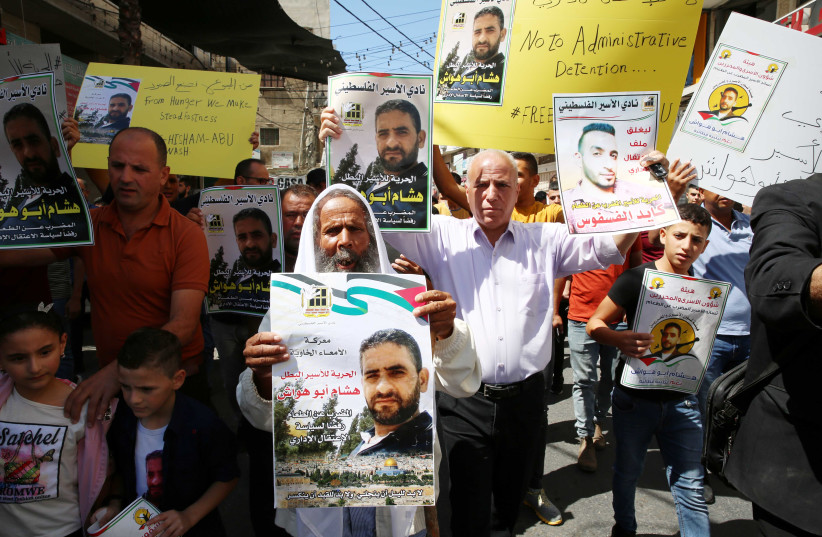Israel has broken a 30-year record for administrative detention of Palestinians, hitting 1,264, the Hamoked NGO has announced.
The human rights NGO received new data from the Israel Prison Service, showing that the number of administrative detainees broke the most recent record of 1,108 from March 2003 at the height of the Second Intifada.
There have not been this many Palestinians in administrative detention since the First Intifada of the late 1980s-early 1990s when the numbers ballooned to 8,000-10,000.
Comparing current statistics to the First Intifada period is not easy, given that at that point in time there were significantly fewer Palestinians on one hand, but Israel also controlled Gaza on the other hand.
In February, Hamoked had previously said that the IDF had broken its record for administrative detentions of Palestinians dating back around 20 years to the 2002-2003 era of the Second Intifada.

But since then, the numbers have increased even more.
Even during the later years of the Second Intifada and during the Knife Intifada of 2015-2016, the number of administrative detainees was more in the 700 range.
In quieter years over the last two decades, the numbers were usually down closer to 200-300 at a time. In the mid-1990s, at the height of the Oslo peace talks, the number fell to single digits.
Administrative detention practice draws international criticism
Over the years, sometimes the US, and regularly Europe, have criticized Israel for using administrative detention and for other tactics like night arrests of Palestinian minors.
However, there are so many other things that the US and Europe are worried about regarding Prime Minister Benjamin Netanyahu's government, from new settlement building, to incitement against Palestinians by some of his coalition partners, to the judicial overhaul, that administrative detention may be the least of their worries.
Executive director Jessica Montell said, "This is a mass, arbitrary detention. Israel is holding over 1,200 Palestinians without charge or trial, some of them for years, with no effective judicial review."
Montel also noted that the total incarceration figures have decreased, which has made administrative detainees now a stunning quarter of all Palestinians in Israeli custody.
Administrative detention may not be valid in the eyes of the US, Europe and much of the human rights community because it abridges standard criminal proceedings and rights.
For example, defense lawyers do not get to see classified evidence whose revelation could expose Israeli intelligence sources and methods. But it still includes judicial proceedings, the judges see all of the classified evidence and most detainees are held for three to 12 months, meaning not forever.
The IDF responded, “the volume of administrative detainees is a consequence of the security danger presented by each individual detainee,” adding that in addition to information about that danger relating to the individual detainee, the defense establishment also takes “into account the security status of the Judea and Samaria area.”
More Israeli civilians have been killed by Palestinian terror attacks in 2023, closing in on 40, than any year since the Second Intifada nearly 20 years ago.
From 2019-2021, combined only around one-third the number of Israelis were killed compared to the first eight months of 2023.
Further, the IDF said, “the use of administrative detention is limited to situations where the security forces have credible and grounded information which indicates a concrete danger that a detainee represents to the security of the area [West Bank] and where there is no alternative to avoiding the danger.”
“Each case of administrative detention includes…a judicial process by the military courts during which the information which is the basis for the detention is substantively reviewed,” said the IDF.
The IDF has said that the administrative detention judicial proceedings are serious and that decisions can be appealed to the High Court of Justice.
On the other hand, it is unclear why Israel's security establishment would feel the need to administratively detain more Palestinians now than during the Second Intifada when Israeli deaths in some years reached into the hundreds.
Sources responded that this is an incorrect comparison, and that the question is not how many Israelis are being killed, but how many substantial violent terror attacks are being attempted and thwarted.
They indicated that there are over 200 warnings per day at different levels and that in 2023 security forces have already thwarted almost 500 substantial violent plotted attacks.
In 2003, during the Second Intifada, the Shin Bet has reported that 12 terror attacks alone with mass-casualty strategies led to 52 dead Israelis.
In 2006, as the Second Intifada faded, the agency said there were still 5,000 Palestinians arrested, similar to the total number of Palestinians arrested in 2023.
But there were 279 arrested likely suicide bombers, said a 2006 Shin Bet report.
There are no exact comparable statistics from 2003-2006 to the categories of 2023, but these last few numbers seem to indicate that a smaller number of Palestinians were doing much more damage during the Second Intifada, but that the number of violent Palestinians in 2023 may be larger.
Other explanations for the disparity between 2023 and the Second Intifada could be changes in intelligence technology which make it easier today to flag a potential terrorist, but where this information may be more often based on evidence which cannot be introduced in regular criminal proceedings without risking exposing sources and methods.
Also, some Israeli allies have criticized the around 150 Palestinians killed by the IDF in the West Bank in 2022, a huge spike compared to prior years, and a trend which has continued and will likely reach higher numbers by the end of 2023.
Either way, the administrative detention issue may also get special attention from the International Criminal Court and the International Court of Justice, both of which have Israel in their crosshairs.
